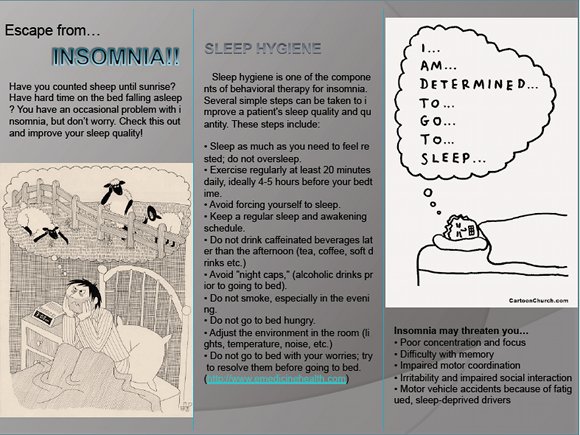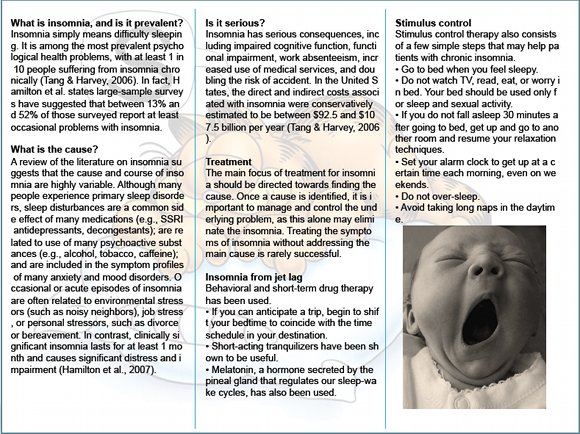
| Connect & Subscribe |
Escape from Insomnia! A Brochure
An Outreach Project by Young Hun Jung | Return To Outreach Projects 2010
The following is a brochure created for Stanford Sleep and Dreams. If it is difficult to read using the images, you may view the full text here.
Also feel free to download this brochure for distributional or general information purposes. Please refer to our privacy policy for our relevant disclaimers.


Have you counted sheep until sunrise? Have hard time on the bed falling asleep? You have an occasional problem with insomnia, but don't worry. Check this out and improve your sleep quality!
SLEEP HYGIENE
Sleep hygiene is one of the components of behavioral therapy for insomnia. Several simple steps can be taken to improve a patient's sleep quality and quantity. These steps include:
Insomnia may threaten you
What is insomnia, and is it prevalent?
Insomnia simply means difficulty sleeping. It is among the most prevalent psychological health problems, with at least 1 in 10 people suffering from insomnia chronically (Tang & Harvey, 2006). In fact, Hamilton et al. states large-sample surveys have suggested that between 13% and 52% of those surveyed report at least occasional problems with insomnia.
What is the cause?
A review of the literature on insomnia suggests that the cause and course of insomnia are highly variable. Although many people experience primary sleep disorders, sleep disturbances are a common side effect of many medications (e.g., SSRI antidepressants, decongestants); are related to use of many psychoactive substances (e.g., alcohol, tobacco, caffeine); and are included in the symptom profiles of many anxiety and mood disorders. Occasional or acute episodes of insomnia are often related to environmental stressors (such as noisy neighbors), job stress, or personal stressors, such as divorce or bereavement. In contrast, clinically significant insomnia lasts for at least 1 month and causes significant distress and impairment (Hamilton et al., 2007).
Is it serious?
Insomnia has serious consequences, including impaired cognitive function, functional impairment, work absenteeism, increased use of medical services, and doubling the risk of accident. In the United States, the direct and indirect costs associated with insomnia were conservatively estimated to be between $92.5 and $107.5 billion per year (Tang & Harvey, 2006).
Treatment
The main focus of treatment for insomnia should be directed towards finding the cause. Once a cause is identified, it is important to manage and control the underlying problem, as this alone may eliminate the insomnia. Treating the symptoms of insomnia without addressing the main cause is rarely successful.
Insomnia from jet lag
Behavioral and short-term drug therapy has been used.
Stimulus control
Stimulus control therapy also consists of a few simple steps that may help patients with chronic insomnia.About This Site
Welcome! This site is continuously being created by students of Dr. William C. Dement's Sleep And Dreams course at Stanford University.
We made this site as a call to action for people all over the world to live healthier, happier, safer, and more productive lives by learning about their own sleep. We have faith that reading the information provided on this site will motivate you to be smart about your sleep deprivation and strategic about your alertness in order to live life to your fullest, most energetic potential.
In fact, we challenge you to do so! What do you say, are you up for the challenge?
Interviews With Sleep Specialists: Insights Into the Worlds of Sleep Medicine & Sleep Business
America's Most Dangerous Disorder: What Is Sleep Apnea Doing To Your Sleep?
Sleep Debt: How Much More Will You Achieve When You Reduce Yours?
The Stages Of Sleep: The Journey Through The Night
Delayed Sleep Phase: You Want To Sleep But You're Not Tired Yet
Paralyzed at Night: Is Sleep Paralysis Normal?
Sleep In Words: Smart, Strange, and Funny Quotes About Sleep
Sleep Disorders In Children: What's Keeping Your Child From A Full Night's Rest?
Attacks of Pavor Nocturnus (a.k.a. Sleep Terrors, Night Terrors, or Incubus Attacks)
The Stanford Sleep Book
Dr. Dement's pioneering textbook has been the core text for Sleep and Dreams since 1980, but it has just recently been made available to the wider public for the first time.
In it you'll find a more detailed account of the most important things you need to know about sleep, alertness, dreams, and sleep disorders. Studies, statistics, plus plenty of Dr. Dement's classic anecdotes painting the history of sleep medicine.
Preface | Intro | Contents | Get A Copy
More Sleep Resources
The Zeo
A revolution in personal sleep tracking, the Zeo is a wireless headband that transmits your brainwaves in realtime to a dock (pictured here) or your smartphone. The result? You can wake up and see exactly what stages of sleep you were in during the night! Unprecedented personalized sleep knowledge.
Sleep Paralysis: A Dreamer's Guide
Ever woken up paralyzed? A surprising number of us have, believe it or not. But few know the actual causes of this phenomenon, and fewer still how to exert control over it. Dream researcher and sleep paralysis expert Ryan Hurd shares breakthrough insights into how to do just that.
Important Disclaimer
Please Note:
The information found on this page and throughout this site is intended for general information purposes only. While it may prove useful and empowering, it is NOT intended as a substitute for the expertise and judgments of healthcare practitioners.
For more info, see our
Terms of Use.









